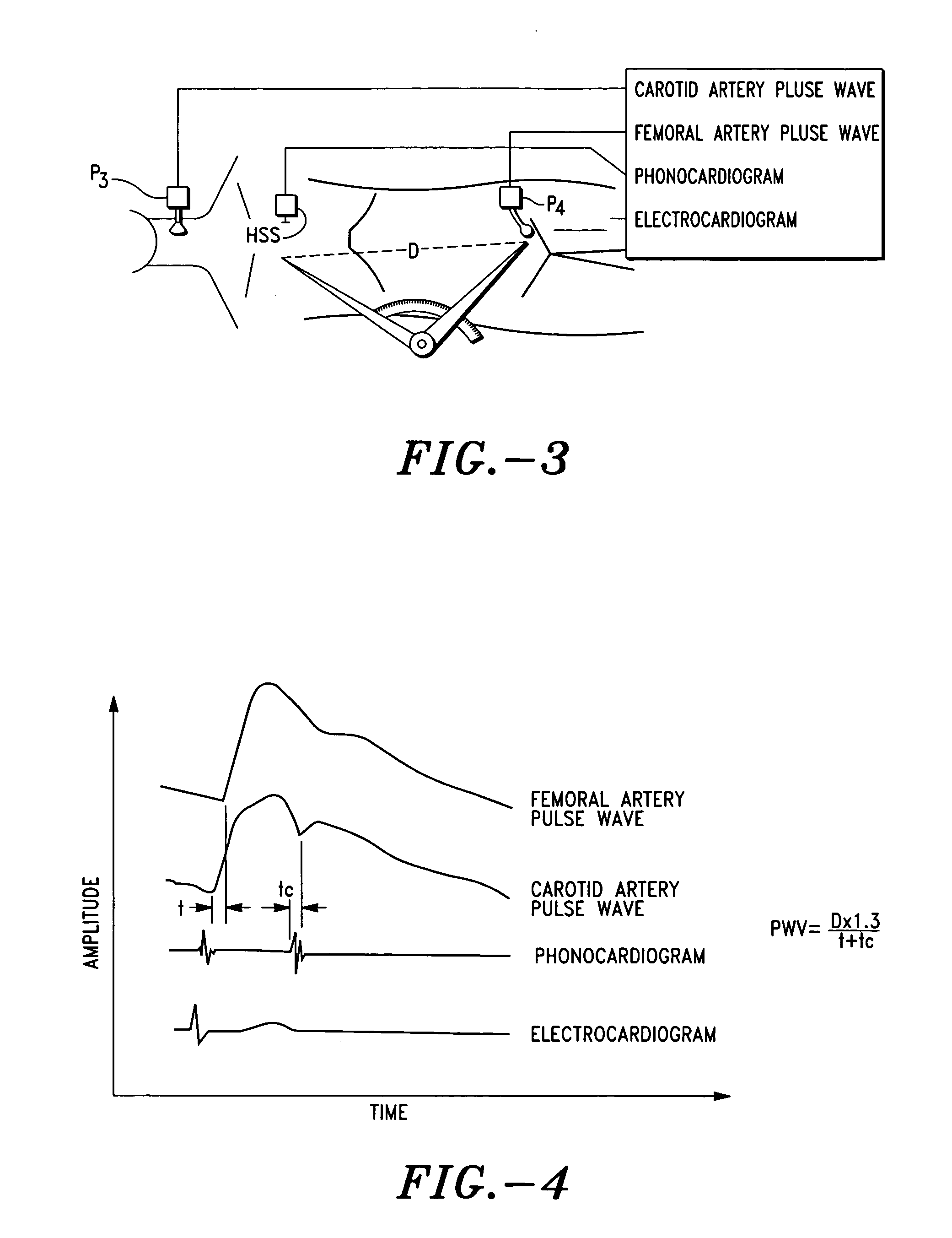Method for determining a cardiac function
a physiological characteristic and cardiac function technology, applied in the field of physiological characteristics associated with cardiac function, can solve the problems of general difficulty in capturing and maintaining accurate pulse wave signals via the noted methods, and methods are susceptible to significant errors, so as to improve accuracy and accuracy of pulse wave velocity determination, increase in pressure and expelling of blood, and reduce pressure
- Summary
- Abstract
- Description
- Claims
- Application Information
AI Technical Summary
Benefits of technology
Problems solved by technology
Method used
Image
Examples
example 1
[0135]An elderly female patient is presented with the following:[0136](i) age: 92 years;[0137](ii) height: 62 inches;[0138](iii) weight: 79 Kg: and[0139](iv) arterial hypertension (systolic pressure=151 mmHg and diastolic pressure=89 mmHg).
[0140]The following basic distances were employed:
D01=D0x+Dx1=8.00 cm+13.00 cm=21 cm; (i)
D02=D0x+Dx2=8.00 cm+74.00 cm=82 cm; and (ii)
D12=D02−D01=82.00 cm−21.00 cm=61 cm. (iii)
[0141]The following measurements were also determined:[0142](i) D0x=8.00 cm;[0143](ii) Dx1=13.00 cm; and[0144](iii) Dx2=74.00 cm.
[0145]From measured patient data the following was also provided:[0146](i) PDDigit=0.1984 seconds; and[0147](ii) PDEar=0.1627 seconds.
[0148]Using a value of 0.88 for ratio parameter αv, pulse wave velocity (PWV) and pre-ejection period (PEP) is then determined, as set forth above, i.e.
PWVCentral=αv×PWVPeripheral=D12×αv(PDDigit-PDEar)=61cm×0.88(0.1984sec-0.1627sec)=1627cmsecPEP=PDEar-(PDDigit-PDEar)*D01(D02-D01)*αage=0.1627sec-(0.1984sec-0.1627...
example 2
[0149]A young normotensive female patient is presented with the following:[0150](i) age: 42 years;[0151](ii) height: 63 inches;[0152](iii) weight: 79 Kg: and[0153](v) arterial hypertension (systolic pressure=130 mmHg and diastolic pressure=7 mmHg).
[0154]The following basic distances were employed:
D01=D0x+Dx1=6.35 cm+13.97 cm=20.32 cm; (i)
D02=D0x+Dx2=6.35 cm+80.01 cm=86.36 cm; and (ii)
D12=D02−D01=86.36 cm−20.32 cm=66.04 cm. (iii)
[0155]The following measurements were also determined:[0156](i) D1=6.35 cm;[0157](ii) D2=13.97 cm; and[0158](iii) D4=80.01 cm.
[0159]From measured patient data the following was also provided:[0160](i) PulseDelayDigit=0.1942 seconds; and[0161](ii) PulseDelayFacial=0.1472 seconds.
[0162]Using a value of 0.88 for ratio parameter αv, pulse wave velocity (PWV) and pre-ejection period (PEP) is then determined, as set forth above, i.e.
PWVCentral=αv×PWVPeripheral=D12×αv(PDDigit-PDEar)=66.04cm×0.88(0.1942sec-0.1472sec)=955cmsecPEP=PDEar-(PDDigit-PDEar)*D01(D02-D0...
PUM
 Login to View More
Login to View More Abstract
Description
Claims
Application Information
 Login to View More
Login to View More - R&D
- Intellectual Property
- Life Sciences
- Materials
- Tech Scout
- Unparalleled Data Quality
- Higher Quality Content
- 60% Fewer Hallucinations
Browse by: Latest US Patents, China's latest patents, Technical Efficacy Thesaurus, Application Domain, Technology Topic, Popular Technical Reports.
© 2025 PatSnap. All rights reserved.Legal|Privacy policy|Modern Slavery Act Transparency Statement|Sitemap|About US| Contact US: help@patsnap.com



